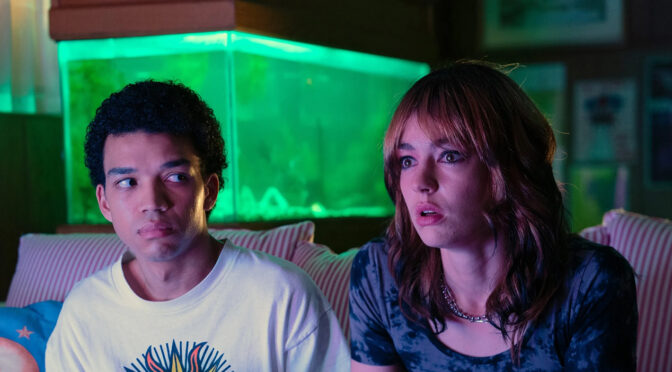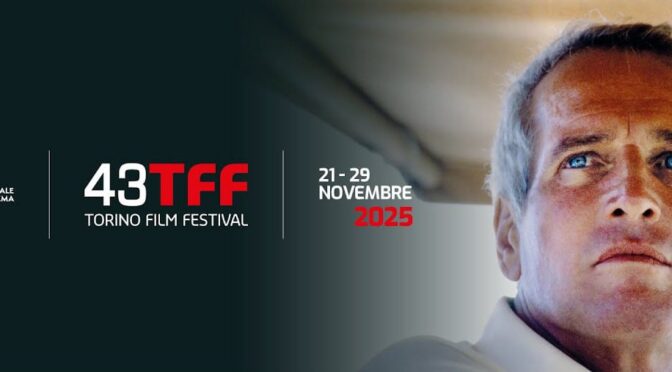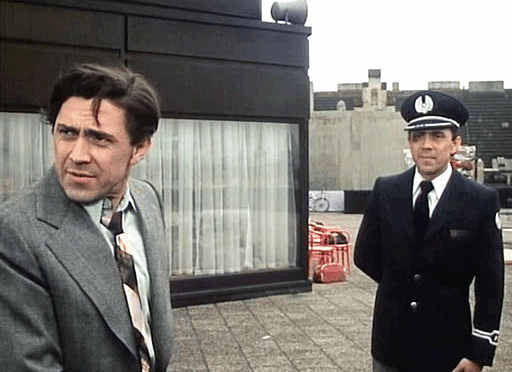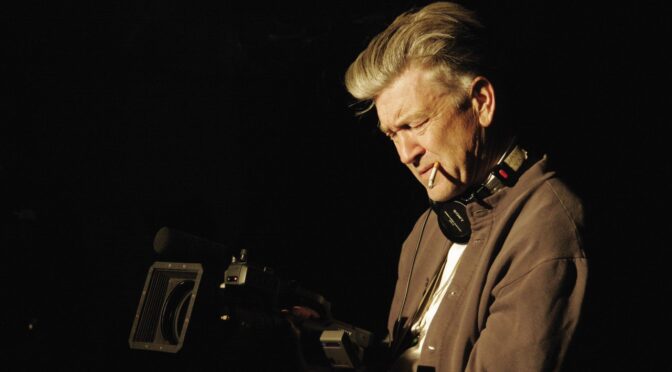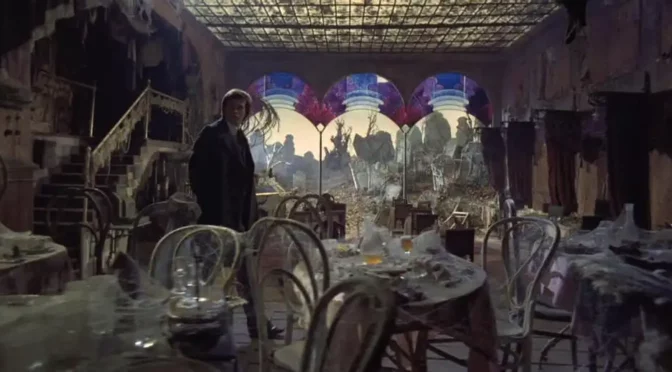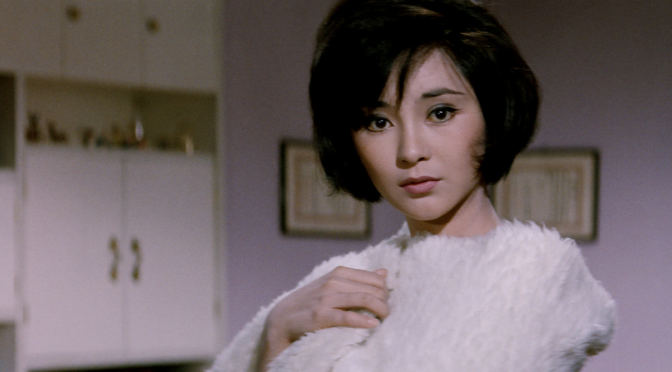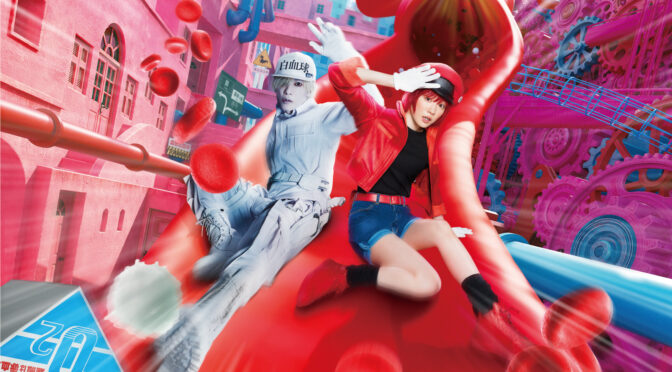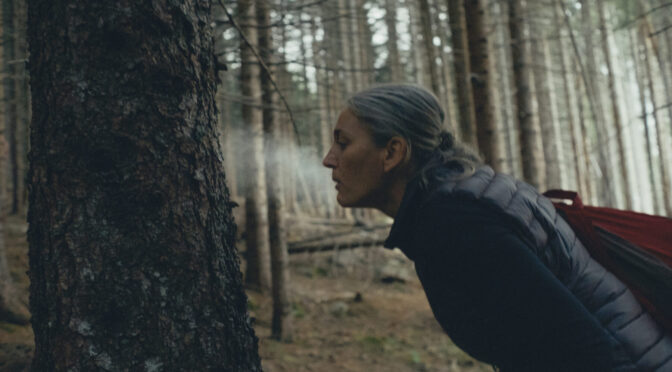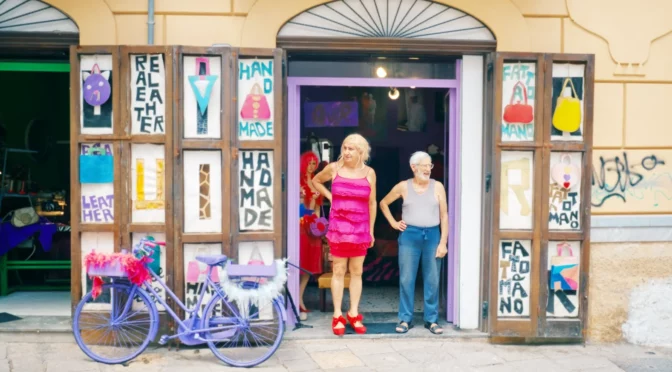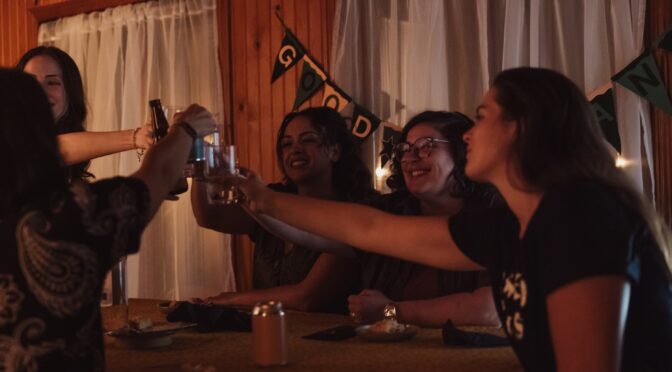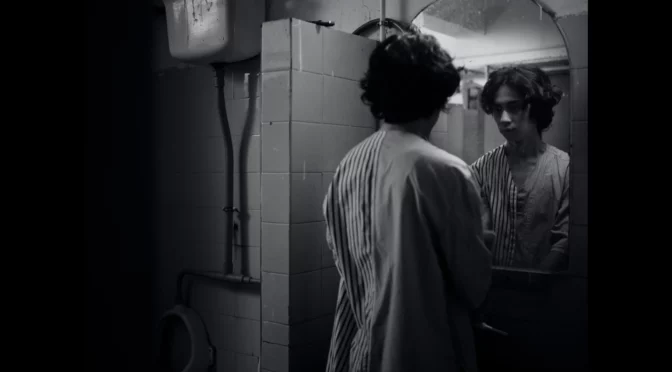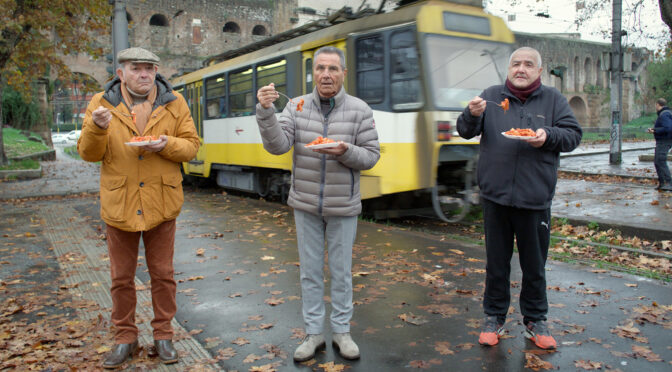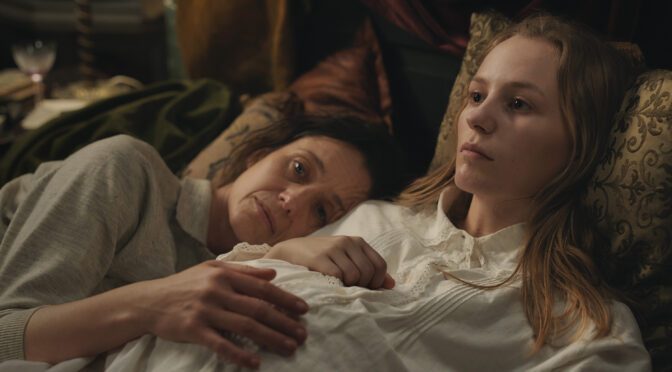Con I Saw the TV Glow, Jane Schoenbrun firma uno dei film più strani, queer e curiosi prodotti dalla casa A24: un’allegoria sull’identità e l’esperienza trans, raccontata attraverso l’horror psicologico e il coming-of-age adolescenziale. Dopo il suo esordio alla regia, Schoenbrun torna a esplorare la relazione intima tra i media, l’adolescenza e la ricerca del sé, ma questa volta attingendo audacemente alla propria esperienza personale per raccontare il percorso di transizione in maniera allusiva e metaforica.
Continua la lettura di “I SAW THE TV GLOW” DI JANE SCHOENBRUN43rd TORINO FILM FESTIVAL’S PRESS CONFERENCE (21-29 NOVEMBER 2025) (ENG)
Article by Alessandra Sottini
Translation by Luca Perrone
On November 7th in Rome, the elegant Acquario Romano venue hosted the press conference presenting the 43rd edition of the Torino Film Festival. This year, the event is adorned with the face and magnetic gaze of Paul Newman, as evident from the poster: a picture shot in 1981 by Eva Sereny, which captures the famous star during the filming of Absence of Malice. It goes without saying that this is one of the twenty-four movies of the Festival paying homage to the actor.
Continua la lettura di 43rd TORINO FILM FESTIVAL’S PRESS CONFERENCE (21-29 NOVEMBER 2025) (ENG)LA CONFERENZA STAMPA DEL 43° TORINO FILM FESTIVAL (21-29 NOVEMBRE 2025)
Il 7 novembre a Roma, presso l’elegante sede dell’Acquario romano, si è svolta la conferenza stampa di presentazione della 43ª edizione del Torino Film Festival. Quest’anno l’evento si veste del volto e degli occhi magnetici di Paul Newman, come si evince dal manifesto: una foto scattata nel 1981 da Eva Sereny, che cattura il celebre divo durante le riprese di Diritto di cronaca (Absence of Malice). Ed è superfluo aggiungere che si tratta di uno dei ventiquattro film dell’omaggio del Festival all’attore.
Continua la lettura di LA CONFERENZA STAMPA DEL 43° TORINO FILM FESTIVAL (21-29 NOVEMBRE 2025)“TOMORROW I’LL WAKE UP AND SCALD MYSELF WITH TEA” DI JINDŘICH POLÁK
Un giorno ti svegli, ti scotti la mano con il te bollente e decidi tuo malgrado di diventare un uomo d’azione, di abbattere il guscio di indolenza che ha segnato la tua monotona quotidianità e vestire i panni tanto agognati di un altro – meglio ancora se di tuo fratello gemello – e tornare indietro nel tempo per sventare il tentativo – maldestro ma pericoloso – di salvare il Terzo Reich dalla disfatta. Un equivoco dopo l’altro scatena il cortocircuito di situazioni tragicomiche che coinvolgeranno il protagonista e i comprimari di Tomorrow I’ll Wake Up and Scald Myself with Tea, non trascurando di evidenziare, diegeticamente e attraverso metafore simboliche, una marcata critica sociale al consumismo sfrenato e massificato.
Continua la lettura di “TOMORROW I’LL WAKE UP AND SCALD MYSELF WITH TEA” DI JINDŘICH POLÁK“NEW GROUP” DI YUTA SHIMOTSU
Se sei cerchio non puoi nascere quadrato (o triangolo); ma puoi provare a cambiare e a pensare con la tua testa. In New Group, il regista Yuta Shimotsu mostra giovani liceali ligi al dovere, chiamati a reattività e performatività ad alti standard; ragazze e ragazzi che devono obbedire a regole prescritte e imposte dagli adulti, che sanno meglio e prima di loro come inserirsi nella società. Infatti, far parte di un gruppo è altamente necessario per non sentirsi esclusi e fuori dal coro. In New Group l’orrore, tuttavia, non si avvale dei facili cliché caratteristici del genere di riferimento. Sono i sottili confini che permeano la normale ordinarietà a rendere inquietante e brutale un sistema gerarchico soffocante e disfunzionale, nella sua messa in opera estrema.
Continua la lettura di “NEW GROUP” DI YUTA SHIMOTSU“ANYTHING THAT MOVES” DI ALEX PHILLIPS
La routine di un sex worker ai tempi delle app di incontri si intreccia con la routine di un serial killer talmente ossessionato da lui da arrivare a decimarne i clienti. Questo sviluppo narrativo sull’eterno accoppiarsi di sesso e morte può forse ricordare Maniac, Hollywood 90028, o Cruising (anche qui i poliziotti incarnano perverse forze del disordine). E come non pensare alla recente trilogia di Ti West, corollario dei body genres di Linda Williams?
Continua la lettura di “ANYTHING THAT MOVES” DI ALEX PHILLIPS“DAVID LYNCH, UNE ENIGME A HOLLYWOOD” DI STEPHANE GHEZ
L’intento di Stéphane Ghez in questo documentario è penetrare la filmografia – e di conseguenza il genio – di David Lynch fino a condurre lo spettatore nelle radici profonde delle sue storie, dove c’è posto solo per gli enigmi architettati con grande maestria da uno dei registi più eclettici di sempre.
Continua la lettura di “DAVID LYNCH, UNE ENIGME A HOLLYWOOD” DI STEPHANE GHEZ“LA CLESSIDRA” DI WOJCIECH JERZY HAS
Alla 25ª edizione del TOHorror, nella sezione “matter(s) of time”, non poteva mancare La clessidra, film apolide di Wojciech Jerzy Has che sfugge a ogni definizione. In un celebre saggio, Cvetan Todorov colloca il fantastico in uno spazio liminale tra lo strano e il meraviglioso. Sospeso nell’indecidibilità surrealista che sfuma la realtà nell’onirico, il film appartiene – e allo stesso tempo si sottrae – alla categoria del fantastico. Tra il grottesco di Fellini e la poesia di Parajanov, Has rilegge e tradisce le irrappresentabili opere di Bruno Schulz in una temporalità che, più che all’oltre-realtà, guarda all’oltretomba.
Continua la lettura di “LA CLESSIDRA” DI WOJCIECH JERZY HAS“LONELY SEVENTEEN” DI PAI CHING-JUI
Con Lonely Seventeen, nel 1967 Pai Ching-jui realizzava un’opera manifesto: un affresco dell’adolescenza e delle sue problematiche, all’interno di un contesto culturale e sociale problematico per via della censura e del controllo statale. A oltre cinquant’anni di distanza, Lonely Seventeen – un titolo di per sé evocativo — offre ancora un racconto fortemente attuale nel ridestare sentimenti e sensazioni assopiti da tempo.
Continua la lettura di “LONELY SEVENTEEN” DI PAI CHING-JUI“CELLS AT WORK!” DI TAKEUCHI HIDEKI
L’unione fa la forza: tutti devono contribuire secondo le loro possibilità e al loro meglio. Questo è il messaggio edificante che Takeuchi Hideki trasmette con Cells at Work!, trasposizione in live-action dell’omonimo manga (e poi anime) ideato dall’estro creativo della mangaka Akane Shimizu. Una storia che celebra le prodezze, date troppe volte per scontate, che il corpo umano è in grado di realizzare.
Continua la lettura di “CELLS AT WORK!” DI TAKEUCHI HIDEKI“IL CODICE DEL BOSCO” DI ALESSANDRO BERNARD, PAOLO CERETTI
“Il nostro lavoro è vedere cose che non ci sono”, dice l’ecologa Monica Gagliano al suo collaboratore Alessandro Chiolerio. I due si trovano sulle alture della Val di Fiemme qualche anno dopo la tempesta Vaia del 2016: il loro obiettivo è utilizzare le tecniche della bioacustica per captare ciò che è rimasto impresso nella “memoria” dei boschi delle Dolomiti a seguito del disastro ambientale. Impresa non facile, visto che gli alberi stanno cominciando a morire a causa di un’epidemia di bostrico, un insetto appartenente alla famiglia dei coleotteri e “specializzato” nel consumare l’abete rosso, ovvero l’albero scelto per la monocoltura della zona in cui i due scienziati stanno facendo ricerca. È solo questione di tempo prima che gli operatori della guardia forestale raggiungano il sito per abbattere gli abeti oggetto dello studio di Gagliano e Chiolerio.
Continua la lettura di “IL CODICE DEL BOSCO” DI ALESSANDRO BERNARD, PAOLO CERETTI“THE NEW JEWS” DI AMIR OVADIA STEKLOV
“A Berlino nessuno chiede ‘da dove vieni?’, ma ‘quale paese ti ha tradito?’”. The New Jews – presentato allo scorso Festival di Rotterdam e in Italia al Lovers Film Festival – racconta l’esperienza di diversi ebrei israeliani fuggiti dal proprio paese, un esodo motivato dal desiderio di prendere le distanze dal governo sionista per cercare rifugio a Berlino.
Continua la lettura di “THE NEW JEWS” DI AMIR OVADIA STEKLOV“QUIR” DI NICOLA BELLUCCI
Quir si apre sulle tombe di un cimitero, un po’ come Volver. Ma, a differenza del film di Almodovar, qui siamo di fronte a una tragica storia vera di cui leggiamo i nomi: Giorgio Agatino Giammona e Antonio Galatola, brutalmente assassinati a Giarre il 31 ottobre 1980, solo perché erano due “ziti” (fidanzati).
Continua la lettura di “QUIR” DI NICOLA BELLUCCI“LAKEVIEW” DI TARA THORNE
Secondo lungometraggio della regista canadese Tara Thorne, Lakeview si presenta nella categoria All The Lovers del 40° Lovers Film Festival come un soffio d’aria fresca. Con un cast tutto al femminile e un’atmosfera dramedy ben costruita, il film si distingue facendo del suo punto di forza una rappresentazione queer, e in particolare lesbica, che semplicemente esiste e si lascia guardare.
Continua la lettura di “LAKEVIEW” DI TARA THORNE“QUEERPANORAMA” DI JUN LI
Il nastro di Möbius è una particolare superficie con una sola faccia. Come già lo era Strade perdute di David Lynch, Queerpanorama – presentato allo scorso Festival di Berlino – è un’applicazione labirintica di questo principio matematico sull’infinitezza, in cui tutto si ripete, ma non ciclicamente, senza una netta distinzione tra il prima e il dopo, il passato e il presente, l’inizio e la fine.
Continua la lettura di “QUEERPANORAMA” DI JUN LI“N-EGO”, BY ELEONORA DANCO
Article by Nicolò Cifarelli
Translation by Linh Carrara
The cold afternoon sun illuminates the pulsating arteries of Rome: in this body, instead of red blood cells, people flow, each with their own past, experiences and aspirations.
Continua la lettura di “N-EGO”, BY ELEONORA DANCO“N-EGO” DI ELEONORA DANCO
Il sole freddo del pomeriggio illumina le arterie pulsanti di Roma: in questo corpo, al posto dei globuli rossi, scorrono le persone, ciascuna con il proprio vissuto, le proprie esperienze e aspirazioni.
Continua la lettura di “N-EGO” DI ELEONORA DANCO“LE RETOUR DU PROJECTIONNISTE” BY ORKHAN AGHAZADEH
Article by Ludovico Franco
Translation by Martina Marino
In the opening lines of Swann’s Way (or The Way by Swann’s), Marcel Proust remembers how, as a child, he loved watching the images projected by the magic lantern: out-and-out apparitions that told stories, like a wavering and ephemeral glass wall. On a foggy hilltop near the border with Iran, the silhouettes of a man and a boy on horseback stand out: the young boy is checking a laptop screen, trying to connect to the internet to purchase the necessary equipment to revive an old analog projector, unearthed by a former projectionist from the USSR. However, the essential element needed to make the magic lantern work is missing: the light, provided by a simple yet elusive lightbulb.
Continua la lettura di “LE RETOUR DU PROJECTIONNISTE” BY ORKHAN AGHAZADEH“LE RETOUR DU PROJECTIONNISTE” DI ORKHAN AGHAZADEH
Nell’incipit della Strada di Swann, Marcel Proust ricorda come da piccolo amasse osservare le immagini proiettate dalla lanterna magica: vere e proprie apparizioni che raccontavano leggende, come in una vetrata vacillante e passeggera. Su un’altura avvolta nella nebbia al confine con l’Iran, si distinguono le silhouettes di un uomo e un ragazzo a cavallo: il giovane controlla lo schermo di un computer portatile, nel tentativo di connettersi alla rete internet e acquistare l’occorrente per riportare in vita un vecchio proiettore analogico, rispolverato da un ex proiezionista dell’URSS. Manca però l’elemento imprescindibile per far funzionare la lanterna magica: la luce, data da una semplice eppure introvabile lampadina.
Continua la lettura di “LE RETOUR DU PROJECTIONNISTE” DI ORKHAN AGHAZADEH“MADAME IDA”, BY JACOB MØLLER
Article by Francesca Strangis
Translation by Federica Lozito
What would one sacrifice for a few crumbs of love after a lifetime of starvation? Perhaps even one’s own freedom. Madame Ida investigates the consequences of lack of love through a tale steeped in tragedy and rich with symbolism.
Continua la lettura di “MADAME IDA”, BY JACOB MØLLER
